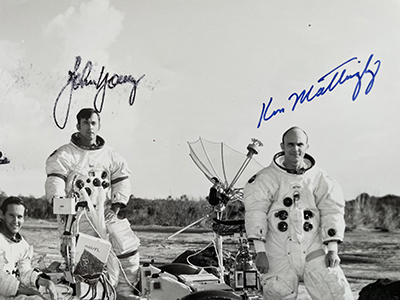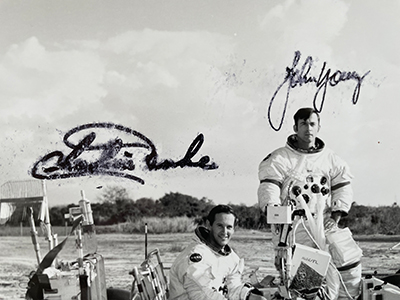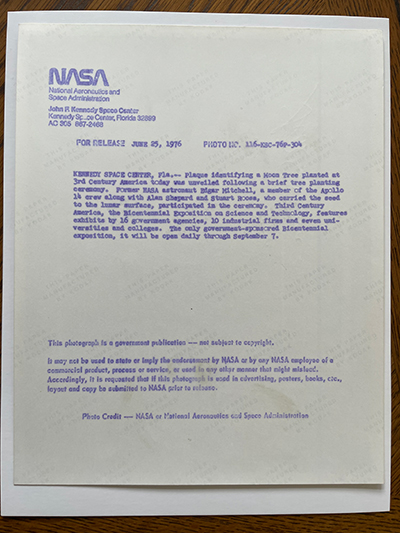|
Author
|
Topic: Advice: ink spread on Apollo 16 signed photo
|
gareth89
Member Posts: 581
From: Ireland
Registered: May 2014
|
 posted 10-02-2023 09:38 AM
posted 10-02-2023 09:38 AM
   
I recently purchased a job lot of signed items with this Apollo 16 crew signed photo. It's a brilliant photo but sadly there is damage to the Charlie Duke and John Young signatures. The photo was in a plastic sleeve and I think that it must have been kept in a damp space as the signatures have dissipated/spread.Would this image be able to be restored to its former glory? Would anyone know anybody with the expertise to repair it? I'd appreciate any advice or input, thanks!  

|
Axman
Member Posts: 187
From: Derbyshire UK
Registered: Mar 2023
|
 posted 10-02-2023 11:16 AM
posted 10-02-2023 11:16 AM
  
The damage is most probably not due to moisture, but by the softeners in old PVC sleeves 'lifting' the ink. (Which is most evident in the transfer of the Young signature, with some of the lifted ink redeposited back onto the photo surface.)It would be quite easy, although expensive, to conserve the piece (with removal of the excess ink redeposited by the Young signature, and cleaning the excess ink around the Duke signature). It's an entirely other matter to "restore/repair" the signatures. What's the point? Not only would it cost more than conservation, but the restored signatures wouldn't be original. I suggest you either live with the damage, or conserve it back to a damaged but cleaner state, and forget entirely about restoration. |
Axman
Member Posts: 187
From: Derbyshire UK
Registered: Mar 2023
|
 posted 10-02-2023 11:58 AM
posted 10-02-2023 11:58 AM
  
To expand slightly on the previous comments.Restoration, though very expensive, is possible. However, the fully restored signatures, whilst passing as signatures to the naked eye, would probably not pass any authentication tests. Therefore it would cost money to have the resulting outcome be worth less money than the damaged but original signatures can fetch. On the other hand, cleaning up ('conserving' as opposed to 'restoring') can not only enhance the visual appeal of the piece, but actually accrue value to it's possible price as it stands (although it's doubtful it would enhance it enough you'd make your money back on the conservation outlay). |
gareth89
Member Posts: 581
From: Ireland
Registered: May 2014
|
 posted 10-02-2023 11:59 AM
posted 10-02-2023 11:59 AM
   
Thanks, I fully agree in terms of restoring, but I'd very much like to clean it up. Do you know of anyone who specializes in this sort of thing? It really goes to show how important proper storage is! |
Axman
Member Posts: 187
From: Derbyshire UK
Registered: Mar 2023
|
 posted 10-02-2023 12:06 PM
posted 10-02-2023 12:06 PM
  
I did know a conserver, but he retired some years ago. I'll make some enquiries but can't promise anything.Meanwhile you could look into this. I can't recommend them, it was just a chance find. Good luck. |
hbw60
Member Posts: 316
From:
Registered: Aug 2018
|
 posted 10-03-2023 12:31 AM
posted 10-03-2023 12:31 AM
   
As mentioned previously, the signatures themselves should not be restored or altered in any way, or they wouldn't be considered authentic.But I had a similar situation where a photograph had been partially lifted by the sleeve, and then "stamped" back onto the photo in blotches. It was a glossy photo, so I was able to get rid of the blotches myself. I used a disposable moist lens-cleaning wipe. I removed it from the package, but I didn't unfold it. That way, I could use stiff narrow corners instead of a large sheet. Then, I very lightly rubbed the blotches with those corners, applying no pressure. The marker stains came right off, without having any effect on the photo underneath. I recommend testing this on a non-important segment of the photo, just to be sure it won't damage it. But I was able to clean the signatures completely in just a few minutes. They looked a little faint and lightly smeared, but nothing as bad as they did before. I also want to mention that even in the current state, this is one of the best Apollo 16 crew-signed photos I've ever seen. That is a fantastic portrait. And the signatures are still perfectly legible. Even if you decide to keep it as-is, it's a top-shelf piece! |
gareth89
Member Posts: 581
From: Ireland
Registered: May 2014
|
 posted 10-04-2023 04:41 AM
posted 10-04-2023 04:41 AM
   
Thanks so much Axman and hbw60, it’s great to get some feedback and leads to chase! I’m in the process of looking into conservators and going to the shops this evening to get some lens wipes to do a test run on a less important piece.It is a great portrait and an awful shame that it got damaged. I’m hoping that I’ll be able to get it cleaned up over time. |
Steve Zarelli
Member Posts: 747
From: Upstate New York, USA
Registered: Mar 2001
|
 posted 10-04-2023 07:47 AM
posted 10-04-2023 07:47 AM
   
There appears to be previous "John Young" signature attempts that were washed off this photo. I'd be concerned about that. |
Axman
Member Posts: 187
From: Derbyshire UK
Registered: Mar 2023
|
 posted 10-04-2023 07:51 AM
posted 10-04-2023 07:51 AM
  
I think the faint Young signatures are where the plasticisers in the PVC cover redeposited lifted ink after the photo was in a different position within the sleeve. I don't think they are "practice" signatures if that is what you mean by it not being a good sign. |
Steve Zarelli
Member Posts: 747
From: Upstate New York, USA
Registered: Mar 2001
|
 posted 10-04-2023 08:00 AM
posted 10-04-2023 08:00 AM
   
I did think of that and you may be right, however it seems to be a lot of movement. |
Axman
Member Posts: 187
From: Derbyshire UK
Registered: Mar 2023
|
 posted 10-04-2023 08:12 AM
posted 10-04-2023 08:12 AM
  
There is certainly a lot of movement, it all depends I suppose on how large the sleeve holding the photo is/was, and whether that amount of movement is feasible.
Also if it is redeposited ink there should still be signs of it remaining on the inside of the plastic sleeve, as much if not more than the faint signatures on the photo.
Can you shed any light on this Gareth? |
hbw60
Member Posts: 316
From:
Registered: Aug 2018
|
 posted 10-04-2023 11:29 AM
posted 10-04-2023 11:29 AM
   
A piece like this really should be authenticated anyway, as part of its conservation and preservation. So after hearing Steve's perspective here, I think it's worth sending it to him for a full LOA.I imagine that once this piece has been handled by a conservator, getting it authenticated might be a bit more difficult. Even if the signatures themselves are not restored, there may be microscopic alterations around the edges that affect Steve's ability to certify them. In person, Steve should also be able to tell if those ghost signatures were lifted/stamped on by the sleeve, or added/erased by hand. So before doing any restoration on the photo, I'd recommend getting the authentication first. Let it be examined in an unaltered state. And then once that's done, even after the restoration, the signatures will still match the LOA, even if they've been cleaned up. |
gareth89
Member Posts: 581
From: Ireland
Registered: May 2014
|
 posted 10-04-2023 03:31 PM
posted 10-04-2023 03:31 PM
   
There was ink on the inside of the sleeve that the photo was in that was deposited by the signatures. As soon as I got the items I removed them and put them in toploaders. I didn't think to keep the sleeves with the ink deposits unfortunately, but I might have some photos I'll have to check.The same happened to a number of items but it was by far the worst on this piece, I thought it was probably because the ink didn't grip as well to the glossy surface? I have a selection of items that I need Steve to check out! |
Axman
Member Posts: 187
From: Derbyshire UK
Registered: Mar 2023
|
 posted 10-05-2023 08:14 AM
posted 10-05-2023 08:14 AM
  
I think hbw60's advice is very sound. Get it authenticated by Mr Zarelli first.(I think personally speaking that they are genuine - though I'm definitely not an expert. However one convincing argument for me is that the "redeposited" signatures are strongest in the areas the "original" signatures are weakest - which in itself seems to rule out "practice signatures" and enhances the probability they are genuine. Plus the Ken Mattingley signature in a completely different ink doesn't seem to have affected in the slightest - which again to me, points in the direction of PVC plasticisers lifting the signature.) |














